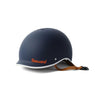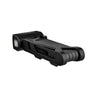If you’ve spent any time looking for an electric bike, you’ll find that they come with either a torque or a cadence sensor. If you’re not familiar with these terms, you might not quite understand how they impact the way you ride the bike, or why torque sensors tend to be more expensive. To help out, we’ve explained the key differences between the two types of sensor, and what sort of ride you can expect when using them.
Let’s dive in.
What is a Cadence Sensor?
Cadence sensors are more common than torque sensors. They work by activating the electric motor when the sensor detects the movement of the pedals. Simply put, it turns on when you start pedalling, and it turns off when you stop pedalling regardless of how hard or fast you pedal.
What are the advantages of a cadence sensor?
The main advantage of a cadence sensor is that you’ll get the full power of your chosen pedal assist level without having to work particularly hard for it - just keep the pedals turning, and the motor will do everything else. This makes for an easy & fast ride, and can give you very quick acceleration.
On top of that, cadence sensors aren’t as complex as torque sensors, so e-bikes that use them are generally cheaper to buy. In a similar vein, cadence sensors are cheaper to replace should you ever damage it.
What are the disadvantages of a cadence sensor?
The disadvantage of cadence sensors is that the electric motor is either on or off. There is no in-between. This can create a jerky ride, and as the motor is always on you can find your battery life goes down quite quickly. If you inadvertently select a high pedal assist level and slightly move the pedals, you may find the bike rockets off the mark in an uncontrolled manner, potentially leading to an accident.
On top of that, each pedal assist mode has its own top speed. For example, pedal assist level 1 will take you to 15 kph, level 2 will take you to 25kph, level 3 will take you to 35 kph and so on. As the motor is either on or off, each pedal assist level will reach its top speed quickly and stay there regardless of your input. This means you could find the top speed of one level too slow, but the top speed of the next level too fast. In this instance, it can be hard to find that balance. You’ll either need to pedal harder to make up the difference, or constantly slow yourself down by stopping pedalling or braking.
This mostly presents a problem in relation to speed limits. For example, the top speed of assist level 1 on the Aventon Soltera is 15kph, while assist level 2 is 25kph. For 20 kph speed limits, you’ll either need to pedal harder on PAS 1, or keep slowing yourself down on PAS 2.
What sort of ride can I expect from a cadence sensor?
Cadence sensors are more fun. You’ll find the bike does most of the work, so if you want to relax & cruise around in style, or if you will be using your bike as a form of transport rather than a form of exercise, go cadence.
You can go fast without having to try particularly hard, which makes them a great way of getting around quickly without breaking a sweat.
Be careful engaging a cadence sensor ebike in a cramped space (like a car park or indoors). They have a tendency to launch off the mark and pay the closest immovable object a visit. This quick launch leads to a quick acceleration, so if this sounds like something you want, cadence sensors are for you.
Go cadence sensor if:
- You want to put in minimal work getting around,
- You like speed and acceleration, but don’t want to work for it,
- You’re on a tight budget,
- You will be cycling over a lot of hills,
- You live in open environments where you can safely ride faster without endangering yourself or others.
Avoid cadence sensors if:
- You want to have full control over your speed,
- You want a smooth ride that compliments your ability rather than takes over,
- You want a more responsive ride,
- You live in areas where police actively enforce speed limits,
- You want a generally more natural riding style.
What is a Torque Sensor?
A torque sensor detects how hard you are pedalling, and will dynamically adjust power output to the motor depending on how much the sensor feels you need help. The harder you pedal, the more power goes to the motor.
What are the advantages of a torque sensor?
A torque sensor creates a very fluid & dynamic ride, much closer to what you’d expect from a regular bicycle. It supports you when you need support, and leaves you be when you’re taking it easy. The result provides an intuitive & dynamic ride that can make riders feel super-human.
As power delivery to the motor is quite fluid and can seamlessly turn on and off without rider input, torque sensors can provide better battery life than cadence sensors.
What are the disadvantages of a torque sensor?
Torque sensors can be an acquired taste, and moving to one from a cadence sensor can be a bit of a shock.
As torque sensors deliver their power based on how hard the rider is pedalling, if you want to go faster you’ll need to pedal harder to engage more power from the motor. This can be a little challenging when tackling hills. Whether you want to maintain or increase your speed while climbing, you’ll need to pedal harder either way. You don’t necessarily need to pedal hard, and torque sensors will still give you an easy ride, but a cadence sensor will just go as hard as it can as long as you keep the pedals moving.
On top of that, torque sensors are more complex than their cadence-driven counterparts, so bikes that carry them tend to be a little more expensive.
What sort of ride can I expect from a torque sensor?
A torque sensor is a lot more natural-feeling than a cadence sensor, so using one is a lot more like riding a regular bike. However, as it compliments your own abilities, it’s a little bit like riding a bike if you had superhuman strength. Every stroke is easier, and pushes the bike further than you would otherwise be able to under your own power. It is easy to find a comfortable speed and stay there, making them better for adhering to local speed limits.
They produce a smooth ride which feels in sync with you. They aren’t hard to cycle uphill either, but you’ll likely find you are putting in more effort to get around hilly routes.
If you’re struggling to comprehend how it feels, then consider how it feels to walk on the moving walkways you find at the airports. When you’re on one, you’re still walking the same way and putting in the same effort, but you’re moving twice as fast. Imagine that but on a bike, and you’ll get a pretty good idea how it feels.
Go for a torque sensor if:
- You want to have full control over your speed,
- You live in reasonably flat areas,
- You live in areas where police actively enforce speed limits for e-bikes,
- You want a ride that feels like it’s working in sync with you,
- You want to keep some of the health benefits associated with cycling
- You want better range from your bike,
Avoid torque sensor if:
- You don’t want to put in any effort to cycling,
- You prefer speed and acceleration without having to try,
- You’re going to be facing a lot of hills,
- You have a tight budget for an e-bike.
Which is Better?
There isn’t really a good answer to this question as it all comes down to rider preference. Generally, we find that people who start riding cadence sensor e-bikes don’t like moving to torque sensors because their riding style has adapted to control the cadence sensor’s more forceful power delivery. However, those who start with torque sensors don’t like the comparative lack of control afforded to them by cadence sensors.
It’s ultimately a matter of perspective. Cadence is cheaper and faster, but harder to control. Torque is more expensive, slower, but offers a more comfortable riding style that feels much closer to riding a regular bicycle, making it an accessible ride.
If you’re not sure which is right for you, give the Electric Kicks team a call for more advice on 1300 054 257 for tailored suggestions on what you should choose.



